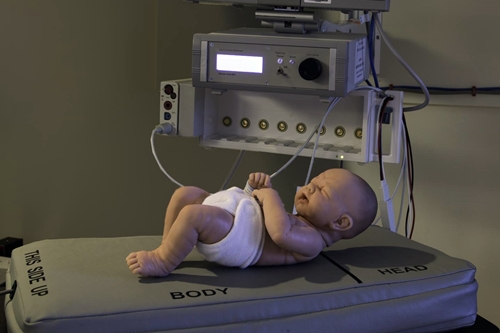24 November 2015. A mattress that provides occasional mild vibrations was shown in a clinical trial to prevent episodes of interrupted breathing in preterm babies, a condition known as infant apnea. Results of the study testing the device, developed at the Wyss Institute, a biomedical engineering research center at Harvard University, were reported yesterday in the journal Pediatrics (paid subscription required).
Babies born prematurely often do not have a fully developed central nervous system that regulates and allows for non-stop breathing. As a result, some babies born before 35 weeks gestation experience periods when apnea occurs, causing their breathing to stop and heart rate to fall. Neonatal intensive care units need to constantly watch for these episodes, which can last up to 2 or 3 months before babies can breath constantly. Low doses of caffeine are given in some cases to keep preterm infants alert and breathing constant.
David Paydarfar, a neurologist on the faculty at Wyss Institute, and University of Massachusetts Medical School in Worcester, led the study testing a mattress for preterm babies designed to prevent apnea episodes. The danger posed by apnea, says Paydarfar in a Wyss Institute statement,”prompted us to develop a non-invasive, non-pharmacological solution that can address the immature respiratory control in these preterm infants.”
The mattress adopts stochastic resonance, a principle from physics where adding random noise to a signal in the right way and right time can improve the detection of that signal. Applied to biological systems, stochastic resonance should improve detection of neurological signals as well. Earlier research by James Collins, a Wyss Institute colleague, shows random vibrations act as noise in stochastic resonance to stimulate greater sensitivity in complex biological systems.
Payfardar, with colleagues at Wyss Institute and UMass medical school, developed a mattress for preterm babies that provides subtle vibrations acting as noise in stochastic resonance, to help regulate breathing and improve heart rates without waking the babies. Based on early pilot studies, the mattress provides vibrations only to the baby’s body to protect the head from adverse effects.
The team tested the device in a clinical trial with 36 preterm babies in the neonatal intensive care unit at Beth Israel Deaconess Medical Center in Boston, affiliated with Harvard Medical School. The babies had an average gestational age of 30.5 months and experienced at least one episode of apnea, low heart rate, or reduced blood oxygen levels. They received intervals of stochastic resonance stimulation for 30 minutes at randomly assigned periods, which were compared to randomly assigned periods of no stimulation. Researchers looked primarily for periods of apnea, low heart rate, and low blood oxygen levels.
The results show during periods when babies received stochastic resonance stimulation, the number of apnea events was reduced by half, compared to similar periods without stimulation. In addition, the number and intensity of low blood oxygen events were reduced by 20 to 35 percent during times of stimulation, and the intensity of low heart rate episodes was reduced by 20 percent.
Wyss Institute says it has patents on the technology, including the equipment, software and algorithms, which are available for licensing from the university.
Read more:
- Vital-Signs Sensors Built Into Ingestible Capsule
- Smartphone Add-On Found Comparable to Pro Stethoscopes
- Wearable Asthma Trigger Detector in Development
- Heart-Powered Leadless Pacemaker in Development
- Mobile App Collecting Placenta Health Data
* * *


 RSS - Posts
RSS - Posts
You must be logged in to post a comment.